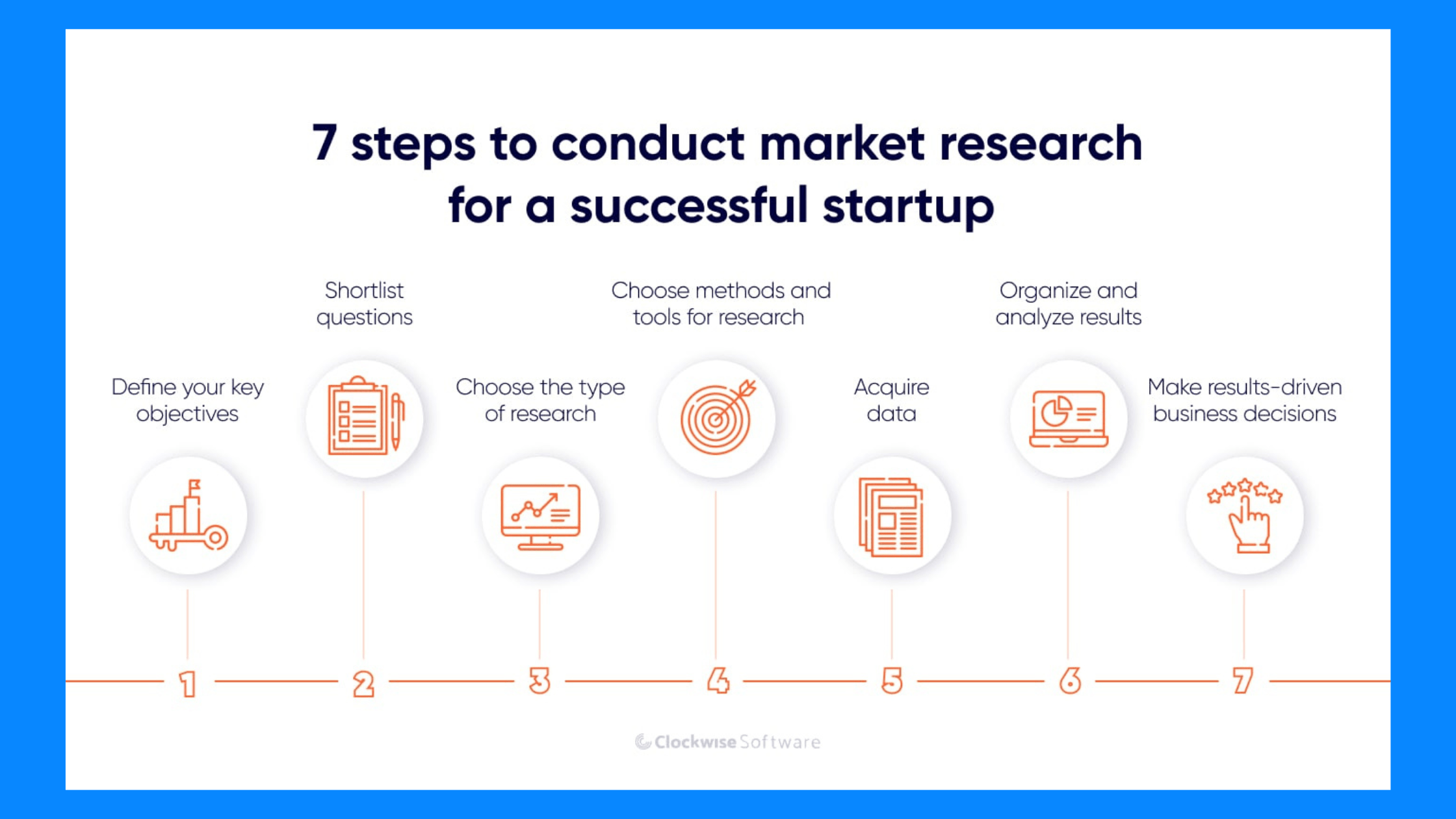The first step of starting a startup is asking questions – “Will people want to buy it? Who will buy?” If you’re not asking these questions to yourself, I’m sorry, your business won’t survive. One of the most important steps in building a thriving business is doing market research. But not many know how to do market research for a startup in India.
Market research helps you understand your customers, competitors, and industry trends. It can make the difference between success and failure. Knowing your market is key, whether you’re launching a startup in Silicon Valley or bustling cities like Mumbai or Bangalore.
In this guide, we’ll learn how to conduct effective market research for your startup, with steps, tips, and examples to help you every step of the way.
What is Market Research for a Startup?
Market research is the process of gathering, analyzing, and interpreting information about a market. For a startup, this means understanding who your customers are, what they want, and how they behave. It also involves looking at your competitors and the overall industry.
The purpose of market research is to provide a solid foundation for your business decisions. By understanding the market, you can create products or services that meet customer needs, set competitive prices, and develop effective marketing strategies.
Without this knowledge, you’re essentially flying blind. You need it to identify opportunities and avoid potential pitfalls.
My experience with Market Research –
I started a digital marketing agency last year, VCMedia Labs. In this business, I help tech founders with company and personal branding. A year ago, this market was hot. Every founder was looking for ghostwriters to create content for them.
Before starting this agency, I reached out to a couple hundred founders on LinkedIn and X. And after talking to a lot of them, I figured that branding isn’t the only solution they want. Founders want leads for their businesses too.
This is how I came up with my service offering. I started my agency with a package of two services – Personal branding and outbound lead generation. It’s been 10 months and I’ve already worked with 20+ clients. See? Easy!
Note: This is a very basic example of market research. But as you move forward with more complex services or products, your market research moves up in difficulty as well.
Why Market Research is Crucial for Startups
Enough blabbering about market research and its importance. I know you must be wondering – “Why is market research important?” Well, here are a few reasons:
- Risk Reduction: Market research helps you identify potential risks before they become problems. By understanding the market, you can make data-driven decisions that reduce uncertainty and minimize risks.
- Identifying Target Audience: Knowing who your customers are is vital. You can’t sell everything to everyone. Market research helps you define your target audience based on demographics, interests, and behaviors. This ensures your product or service meets their needs.
- Understanding Competitors: To succeed, you need to know who you’re up against. Market research provides insights into your competitors’ strengths and weaknesses. This knowledge helps you differentiate your startup and find a competitive edge.
- Anticipating Market Trends: The market is always changing. Market research helps you stay ahead of trends, so you can adapt and innovate. By anticipating changes, you can position your startup for long-term success.
Types of Market Research
There are two types of market research: Primary and Secondary. Before you assume – “Which one should I opt for my business research?” Wait!
First, understand each type of market research and then decide. Pro tip: you can always pick both to have a broader spectrum of market research.
1. Primary Research
Primary research involves collecting new data directly from the source. You can do this through surveys, interviews, and focus groups. It’s firsthand information that gives you specific insights into your market.
- Surveys: Surveys are a great way to gather large amounts of data. You can distribute them online or in person. Keep your questions clear and concise to get accurate results. Tools like Google Forms or SurveyMonkey can be very helpful.
- Interviews: **Interviews provide deeper insights through one-on-one conversations. They can be done in person, over the phone, or via video calls. Prepare your questions in advance and be open to follow-up questions based on responses.
- Focus Groups: Focus groups involve a small group of people discussing a topic. This method provides qualitative data and can reveal deeper motivations and opinions. It’s useful for getting feedback on new ideas or products.
2. Secondary Research
Secondary research involves analyzing existing data from various sources. This includes reports, studies, and online data. It’s a cost-effective way to gather information.
- Reports and Studies: Look for industry reports and academic studies that provide valuable data and insights. Websites like Statista and government databases can be useful.
- Online Data: Explore online resources like market research websites, industry blogs, and social media. These sources can provide current information and trends.
Now, by combining primary and secondary research, you can get a broader understanding of your market. I used both types for my business. My primary research involved interviewing founders and secondary research involved getting online data through social media content and polls.
A friendly advice – If you can, use both market research types for your business.
How to do Market Research for a Startup in India?
Before we start with the process, I want you to know that market research isn’t a quick process. You can’t get it done in a day or week. There is no shortcut. Quality market research often takes weeks or even months.

Source: Clockwise Software
Step 1: Define Your Objectives
Before diving into market research, clarify what you need to learn and why. Are you looking to understand customer preferences, identify market trends, or assess the competition in your chosen market? Clear objectives help you focus your research and make the process more efficient.
Examples relevant to Indian startups:
- Suppose you’re launching a food delivery service in Mumbai. Your objective might be to understand the demand for different cuisines and identify the busiest delivery times.
- For a tech startup in Bangalore, you might want to explore the adoption rate of new technologies among local businesses.
Step 2: Identify Your Target market
I’m saying it again – You can’t sell to everyone. Knowing your target market is crucial. This involves segmenting your audience based on demographics (age, gender, income) and psychographics (lifestyle, values, interests).
Use tools like Google Analytics and social media insights to gather data on your audience. Surveys and focus groups can also provide valuable information.
Specific tips for Indian startups:
- Consider regional differences within India. Preferences can vary widely between urban and rural areas.
- For instance, a fashion startup in Delhi might target young, urban professionals, while one in a smaller city might focus on traditional wear for different age groups.
Step 3: Select a Research Method (Qualitative or Quantitative)
Choose between qualitative and quantitative research methods based on your objectives.
Qualitative Research: is exploratory and focuses on understanding the underlying reasons, opinions, and motivations of your target audience. It provides in-depth insights into people’s attitudes and behaviors.
Quantitative Research: involves collecting numerical data that can be measured and analyzed statistically. This method is useful for testing hypotheses and making data-driven decisions.
Choosing the Right Method
Your choice between qualitative and quantitative research depends on your objectives:
- Use qualitative research when you need to explore new ideas, understand underlying motivations, and gather detailed insights. It’s particularly useful in the early stages of product development or when entering a new market.
- Use quantitative research when you need to validate hypotheses, measure variables, and make data-driven decisions. It’s ideal for scaling up and optimizing existing products or services.
For a comprehensive market understanding, combining both methods is often the best approach.
Step 4: Gather Data
This step involves collecting information through both primary and secondary research methods.
Primary data collection methods: Use surveys, interviews, and focus groups to gather firsthand information. For instance, you could survey customers about their preferences or conduct interviews to understand their pain points.
Secondary data sources: Analyze existing reports, market studies, and online data to gain a broader understanding of the market. Websites like Statista, government databases, and industry publications are valuable resources.
Using local Indian data sources and tools: Leverage data from Indian market research firms, local government reports, and industry associations. Platforms like YourStory and Inc42 provide insights specific to Indian startups.
Step 5: Analyze the Data
Once you have collected the data, analyze it to uncover patterns and insights.
Data analysis techniques: Use tools like Excel, Google Sheets, or specialized software like SPSS for quantitative data. For qualitative data, identify common themes and trends through coding and thematic analysis.
Interpreting results for actionable insights: Look for key takeaways that align with your objectives. For example, if your survey reveals a high demand for eco-friendly products, consider how you can incorporate sustainability into your business model.
Step 6: Implement Findings
The final step is to apply the insights gained from your research to your business strategies.
Applying insights to business strategies: Use your findings to refine your product or service offerings, improve marketing strategies, and make informed decisions about pricing and distribution.
Examples of successful implementation:
- A startup in Mumbai might discover through research that there’s a growing demand for organic food. They could then focus on sourcing organic ingredients and highlighting this in their marketing campaigns.
- Similarly, a tech startup in Bangalore might find that small businesses need affordable software solutions, leading them to develop budget-friendly packages tailored to this market.
Conclusion
Now that we have talked about market research and the steps to conduct it, let me give you a pro tip:
The fastest and easiest way to gather market research today is through social media. Platforms like LinkedIn, Twitter, and Instagram give you instant access to your target audience, letting you gather insights quickly. By engaging with your audience, running polls, and analyzing comments, you can understand customer preferences, spot trends, and get feedback in real time.
This is why many founders and entrepreneurs are creating content and building brands on social media. Now, if you want to be a founder too, start building your brand online and gather customer data.











Leave feedback about this